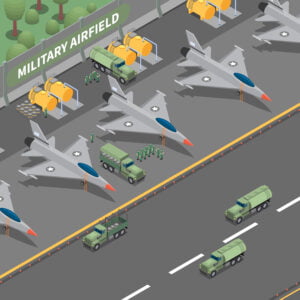Introduction to ARINC 818-2 Standard
In the realm of aviation and aerospace, where reliability, efficiency, and interoperability are paramount, standards play a crucial role in ensuring seamless communication and operation. Among these standards, ARINC 818-2 stands out as a cornerstone for high-speed video and data transmission in avionics systems.
Brief History and Purpose
The Aeronautical Radio, Incorporated (ARINC) developed the ARINC 818 standard to address the increasing demand for high-performance avionics video systems in both military and commercial aircraft. Initially introduced as ARINC 818-1, this standard has undergone evolution and refinement, culminating in the release of ARINC 818-2.
Overview of ARINC
ARINC, established in 1929, has been a leading provider of standards and solutions for the aviation industry. Its standards are widely adopted by manufacturers, airlines, and regulatory bodies, ensuring compatibility and reliability across diverse aviation systems.
Evolution from ARINC 818-1 to ARINC 818-2
With advancements in technology and the evolving needs of modern aircraft, ARINC 818-2 represents a significant update over its predecessor. It introduces enhanced features, improved performance, and updated protocols to meet the ever-growing demands of avionics systems.

ARINC 818-2 standard, Characteristics
Bandwidth:
The fiber-channel protocol offered link rates of 1.0625, 2.125, 4.25, and 8.5 gigabits per second (Gbps) at the time ARINC 818 was ratified. In order to meet market demand, link rates of 14.025 and 28.05 Gbps have since been made available. Even faster speeds are in the works.
ARINC 818-2 introduced rates of 5.0, 6.375 (FC 6x), 12.75 (FC 12x), 14.025 (FC 16x), 21.0375 (FC 24x), and 28.05 (FC 32x) Gb/s. In order to support the use of high-speed, bi-directional coax as a physical medium with power, the 6x, 12x, and 24x speeds were added. The specification was expanded to include the option to define non-standard link rates for bi-directional return channels in situations when high-speed video communications are not necessary, like camera control.
Switching:
The point-to-point communication system known as the ARINC 818 protocol was developed. With the rising number of displays and/or ARINC 818 channels (10 or more) in many contemporary ARINC 818 implementations, switching has become more and more important. To ensure interoperability, the standard only defined a few stringent requirements.
It just offered guidance on how to handle other components using the project ICD in order to achieve flexibility. Because of Fiber Channel heritage, ARINC 818 containers feature source and destination IDs. Routing based on those addresses is feasible, but it would be challenging to accomplish in the case of music or data because latency can increase before the payload is finished and container size can fluctuate.
Compression and Encryption:
ARINC 818 was originally designed to transmit just uncompressed audio and video. Applications such as data-only apps, UAV/UAS with bandwidth-limited downlinks, and high-resolution sensors necessitated the compression and/or encryption of a communication. The only information included in the ARINC 818 containers were flags indicating if the payload (data, video, or audio) was compressed, encrypted, or both.
According to the ARINC 818 philosophy of maximum flexibility, the implementation details are described in the Interface Control Document (ICD) for each project.
Channel Bonding:
Numerous parallel lines can get around FPGA bandwidth limitations thanks to ARINC 818-2. The video frame is transmitted via two or more channels after being divided into smaller pieces. Each link must send a full ADVB frame with a header, and the ICD handles latency and skew between the links.
For instance, a WQXGA (2560 x 1600 pixels) image with 24-bit color depth at 60 Hz would require 737,280,000 B/s of bandwidth, according to one of those discussed on Aviation Today. Using channel bonding, this image may be divided and delivered over two ARINC 818 4.25 Gbps lines. The ICD for that project specifies how the video should be re-split.
Data-only Links:
Data-only communications are commonly employed as channels for command and control. A typical ARINC 818 link, for instance, may transmit the video stream from a camera or sensor. The camera would get a data-only link that would be used to carry out operations like focus and white balance.
ARINC 818-2 is compatible with data-only links, which are frequently utilized in command-and-control channels, like those needed for bi-directional camera interfaces. For these, the ICD may define a non-standard rate or a regular link rate.
Field Sequential Color:
By sending each color component in its own container, the field sequential color mode allows for broadcasting of colors beyond than only the basic primary colors. A code for the video format was added in order to support field sequential color. The color field-sequential mode typically sends each color component in its container.
These days, transparent, wearable displays like head or helmet-mounted displays and less costly displays without color filters are being made possible by new LCD technology.
Bi-directional Camera Interfaces:
In this case, a bit is given to signal that the video channel should synchronize on the Start of Frame Initiate (SOFi) symbol and that the container is a sync marker. This makes it possible to synchronize many cameras with the packet, which facilitates operations like blending and merging. Despite the fact that a bi-directional camera interface is essentially a data-only link, it was thought that these implementations should have some advice.
CRC Calculation:
One of the trickier parts of implementing ARINC 818-1 was accurately determining the previous image CRC. Because the CRC computation is intricate, it is easy to perform it incorrectly.
Applications of ARINC 818-2
ARINC 818-2’s versatility and robustness make it an integral component in various applications across the aviation and aerospace sectors. From military aircraft to commercial airliners, its capabilities facilitate efficient data and video transmission, enhancing safety, situational awareness, and operational effectiveness.
Avionics Systems

- Cockpit Displays: In modern aircraft, cockpit displays play a vital role in providing pilots with critical flight information, such as navigation data, engine parameters, and system status. ARINC 818-2 enables high-speed transmission of graphics and video to these displays, ensuring real-time updates and clarity of information.
- Heads-Up Displays (HUDs): HUDs project essential flight data directly onto the pilot’s field of view, enhancing situational awareness and reducing the need to divert attention from the external environment. ARINC 818-2 supports HUD systems by delivering high-resolution graphics and symbology with minimal latency.
- Mission Systems: Military aircraft rely on mission systems for tasks such as surveillance, reconnaissance, and targeting. ARINC 818-2 facilitates the integration of sensors, cameras, and mission computers, enabling seamless communication and data sharing among these components.
Military and Aerospace Applications

- Fighter Jets: High-performance fighter aircraft demand robust avionics systems capable of withstanding extreme conditions and delivering superior performance. ARINC 818-2 meets these requirements by providing high-bandwidth data transmission, low-latency video delivery, and enhanced reliability for mission-critical operations.
- Unmanned Aerial Vehicles (UAVs): UAVs, or drones, play an increasingly vital role in military reconnaissance, surveillance, and combat operations. ARINC 818-2 enables UAVs to transmit high-definition video feeds to ground control stations in real-time, facilitating informed decision-making and effective mission execution.
- Spacecraft: ARINC 818-2’s adaptability extends beyond the Earth’s atmosphere, serving as a reliable communication standard for spacecraft and satellite systems. Whether transmitting telemetry data, video feeds, or command signals, ARINC 818-2 ensures seamless connectivity and data exchange in space missions.

- In-Flight Entertainment (IFE) Systems: Passengers expect high-quality entertainment options during their flights, ranging from movies and TV shows to interactive games and live streaming. ARINC 818-2 supports the delivery of multimedia content to seat-back displays and personal devices, enhancing the inflight experience for travelers.
- Cabin Management Systems: Airlines utilize cabin management systems to control various onboard amenities, including lighting, temperature, and audiovisual entertainment. ARINC 818-2 facilitates communication between cabin controllers and distributed subsystems, enabling seamless integration and operation of cabin features.
- Passenger Displays: From flight status updates to safety instructions, passenger displays play a crucial role in conveying information to travelers throughout their journey. ARINC 818-2 ensures the timely delivery of multimedia content to these displays, enhancing communication and engagement with passengers.
Conclusion
ARINC 818-2 is a pivotal standard in aviation and aerospace communication, embodying reliability, efficiency, and adaptability. Its enhanced features, improved performance, and compatibility with existing systems underscore its importance in addressing the evolving needs of aircraft manufacturers, operators, and passengers.
The adoption of ARINC 818-2 is set to revolutionize avionics systems, streamlining development efforts, accelerating time-to-market, and fostering interoperability. As aerospace communication standards evolve, ARINC 818-2 serves as a benchmark for performance, reliability, and security, guiding the industry towards a future of innovation and excellence in air travel






